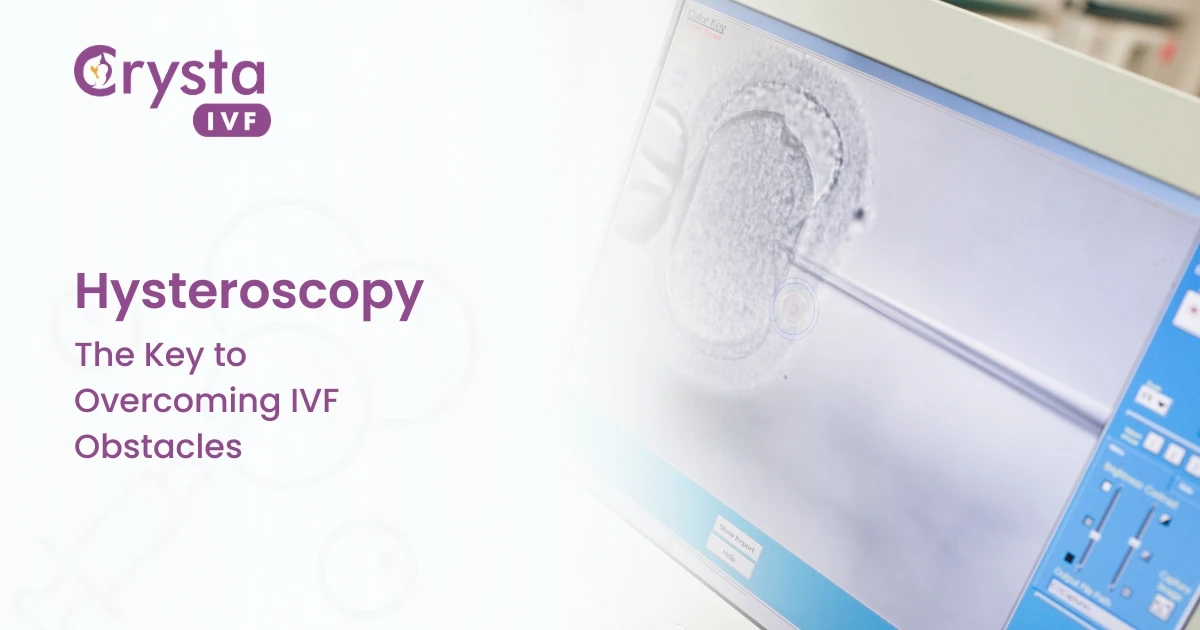In vitro fertilization (IVF) has revolutionized fertility treatment, helping millions of couples worldwide conceive and start a family.
If you’re considering fertility treatments like IVF, you might have come across the term “hysteroscopy.” But what is hysteroscopy, and how does it relate to IVF?
This comprehensive guide will provide you with everything you need to know about hysteroscopy and its role in IVF, from understanding what hysteroscopy means to learning about its benefits and how it can improve IVF outcomes. So, let’s first understand hysteroscopy.
What is Hysteroscopy?
Hysteroscopy is a less-invasive diagnostic procedure in fertility treatments like in vitro fertilization (IVF). The process involves inserting a small, lighted telescope known as a hysteroscope through the vagina and cervix and into the uterus.
This allows doctors to closely look into the uterus to inspect the uterine cavity for any abnormalities, such as –
- Uterine fibroids
- Polyps
- Adhesions
- Other structural issues
These issues can cause trouble with the implantation and pregnancy.
Additionally, hysteroscopy can also be used to remove any abnormalities found during the procedure, such as polyps or fibroids, which may improve IVF success rates.
Benefits:
- Hysteroscopy allows for a visual inspection of the uterus, detecting any structural abnormalities that may hinder implantation or pregnancy.
- Any abnormalities found during the procedure can often be treated immediately, improving IVF success rates.
- The procedure does not require general anesthesia, meaning it can be performed outpatient, and recovery time is usually quick.
Risks:
- As with any other medical procedure, some risks include bleeding, infection, and damage to the uterus or other organs.
- In rare cases, complications can occur, such as perforation of the uterus or allergic reaction to medication used during the procedure.
However, the overall risk of complications is low, and the benefits of hysteroscopy often outweigh the potential risks, particularly in cases involving fertility treatment.
Steps Involved in a Hysteroscopy Procedure
Hysteroscopy is often performed before IVF treatment to identify and treat any structural issues that may affect implantation or pregnancy.
If any abnormalities are found during hysteroscopy, removing them can improve the chances of a successful IVF cycle. Here are the steps involved:
- Before the procedure, the patient may receive medication to help relax or numb the cervix.
- The hysteroscope device is inserted through the vagina and cervix into the uterus.
- A liquid or gas is then introduced to expand the uterine cavity, allowing the fertility specialist to visualize any abnormalities better.
- Any abnormalities found during the procedure can often be treated immediately, such as removing polyps or fibroids.
- After the procedure, the patient may experience mild cramping or vaginal bleeding.
Hysteroscopy: Recovery and Aftercare
Patients may experience mild cramping or vaginal bleeding following the procedure, but these symptoms typically resolve within a few days.
It is essential to follow the instructions provided by the fertility specialist to ensure proper healing and reduce the risk of complications. Patients will then have a follow-up appointment with their specialist to ensure they are healing properly and to discuss the hysteroscopy results.
While complications from hysteroscopy are rare, patients should be aware of the signs of potential complications, such as fever, heavy bleeding, severe pain, or signs of infection. They should seek medical attention if any of these occur.
Role of Hysteroscopy in IVF
It plays a vital role in in vitro fertilization (IVF) treatment. Before beginning IVF, fertility doctors often recommend a hysteroscopy procedure to identify any structural issues in the uterus that may affect implantation and pregnancy. Detecting and treating abnormalities can improve the chances of a successful IVF cycle.
In some cases, hysteroscopy can be used during the IVF cycle to confirm the correct placement of embryos during embryo transfer.
Difference Between Hysteroscopy & Hysterectomy
While the terms hysteroscopy and hysterectomy may sound similar, they are very different procedures.
Hysteroscopy allows a fertility specialist to examine the uterus for any abnormalities. On the other hand, hysterectomy is a surgical procedure in which the uterus is completely removed.
Hysterectomy is typically only performed in cases with a serious medical issue, such as cancer or severe endometriosis, and is not a fertility treatment.
It is essential to understand the differences between these two procedures, as they have vastly different implications for a woman’s reproductive health.
A Word From Crysta IVF
If you’re having trouble conceiving or have undergone an unsuccessful IVF cycle, seeking medical advice is essential. Hysteroscopy can be crucial in identifying and treating any structural issues in the uterus that may hinder IVF success.
At Crysta IVF, the best IVF center in India, our medical experts have decades of experience treating infertility and helping couples realize their dream of parenthood. We understand that infertility can be a difficult and emotional journey, and we are committed to providing compassionate and personalized care to each patient.
If you’re considering fertility treatment, get in touch with us today for the right guidance and treatment.




